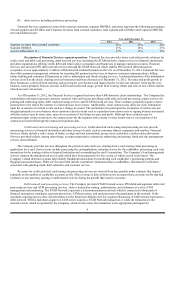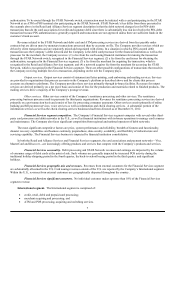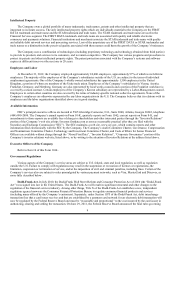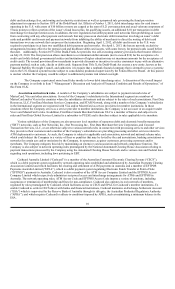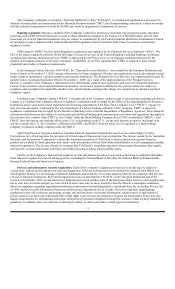First Data 2012 Annual Report Download - page 16
Download and view the complete annual report
Please find page 16 of the 2012 First Data annual report below. You can navigate through the pages in the report by either clicking on the pages listed below, or by using the keyword search tool below to find specific information within the annual report.
Changes in card association and debit network fees or products could increase costs or otherwise limit the Company’s operations.
From time to time, card associations and debit networks increase the organization and/or processing fees (known as interchange
fees) that they charge. It is possible that competitive pressures will result in the Company absorbing a portion of such increases in the
future, which would increase its operating costs, reduce its profit margin and adversely affect its business, operating results and
financial condition. Furthermore, the rules and regulations of the various card associations and networks prescribe certain capital
requirements. Any increase in the capital level required would further limit the Company’ s use of capital for other purposes.
The Company depends, in part, on its merchant relationships and alliances to grow the Company’s Retail and Alliance Services
business. If the Company is unable to maintain these relationships and alliances, the Company’s business may be adversely
affected.
Growth in the Company’ s Retail and Alliance Services business is derived primarily from acquiring new merchant relationships,
new and enhanced product and service offerings, cross selling products and services into existing relationships, the shift of consumer
spending to increased usage of electronic forms of payment and the strength of the Company’ s alliance partnerships with banks and
financial institutions and other third parties. A substantial portion of the Company’ s business is conducted through “alliances” with
banks and other institutions. The Company’ s alliance structures take on different forms, including consolidated subsidiaries, equity
method investments and revenue sharing arrangements. Under the alliance program, the Company and a bank or other institution form
an alliance, either contractually or through a separate legal entity. Merchant contracts may be contributed to the alliance by the
Company and/or the bank or institution. The banks and other institutions generally provide card association sponsorship, clearing and
settlement services. These institutions typically act as a merchant referral source when the institution has an existing banking or other
relationship. The Company provides transaction processing and related functions. Both alliance partners may provide management,
sales, marketing, and other administrative services. The alliance structure allows the Company to be the processor for multiple financial
institutions, any one of which may be selected by the merchant as their bank partner. The Company relies on the continuing growth of
its merchant relationships, alliances and other distribution channels. There can be no guarantee that this growth will continue. The loss
of merchant relationships or alliance and financial institution partners could negatively impact the Company’ s business and result in a
reduction of the Company’ s revenue and profit.
The Company may experience breakdowns in its processing systems that could damage customer relations and expose it to liability.
The Company depends heavily on the reliability of its processing systems in the Company’ s core businesses. A system outage or
data loss could have a material adverse effect on the Company’ s business, financial condition and results of operations. Not only would
the Company suffer damage to its reputation in the event of a system outage or data loss, but the Company may also be liable to third
parties. Many of the Company’ s contractual agreements with financial institutions require the payment of penalties if the Company’ s
systems do not meet certain operating standards. To successfully operate the Company’ s business, the Company must be able to protect
its processing and other systems from interruption, including from events that may be beyond the Company’ s control. Events that could
cause system interruptions include, but are not limited to, fire, natural disaster, unauthorized entry, power loss, telecommunications
failure, computer viruses, terrorist acts and war. Although the Company has taken steps to protect against data loss and system failures,
there is still risk that it may lose critical data or experience system failures. The Company performs the vast majority of disaster
recovery operations itself, though it utilizes select third parties for some aspects of recovery, particularly internationally. To the extent
the Company outsources its disaster recovery, it is at risk of the vendor’ s unresponsiveness in the event of breakdowns in the
Company’ s systems. Furthermore, the Company’ s property and business interruption insurance may not be adequate to compensate it
for all losses or failures that may occur.
The Company may experience software defects, computer viruses and development delays, which could damage customer relations,
decrease the Company’s potential profitability and expose it to liability.
The Company’ s products are based on sophisticated software and computing systems that often encounter development delays,
and the underlying software may contain undetected errors, viruses or defects. Defects in the Company’ s software products and errors
or delays in the Company’ s processing of electronic transactions could result in:
• additional development costs;
• diversion of technical and other resources from the Company’ s other development efforts;
• loss of credibility with current or potential customers;
• harm to the Company’ s reputation; or
• exposure to liability claims.
16


